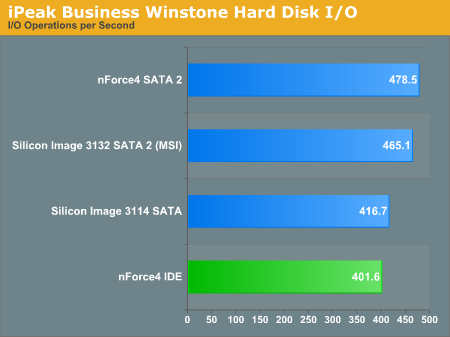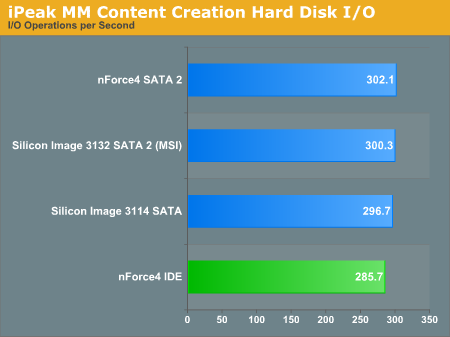nForce4 SLI Roundup: Painful and Rewarding
by Wesley Fink on February 28, 2005 7:00 AM EST- Posted in
- Motherboards
Disk Controller Performance
With so many storage controllers on the nForce4 SLI boards, we needed a means of comparing performance of the wide variety of controllers. The logical choice was Anand's storage benchmark first described in Q2 2004 Desktop Hard Drive Comparison: WD Raptor vs the World. To refresh your memory, the iPeak test was designed to measure "pure" hard disk performance, and in this case, we kept the hard drive as consistent as possible while varying the hard drive controller. The idea is to measure the performance of a hard drive controller with a consistent hard drive. We played back Anand's raw files that recorded I/O operations when running a real world benchmark - in this case, the entire Winstone 2004 suite. Intel's IPEAK utility was then used to play back the trace of all the IO operations that take place during a single run of Business Winstone 2004 and MCC Winstone 2004. To try to isolate performance difference to the controllers that we were testing, we used Seagate 7200.7 model SATA and IDE hard drives for all tests.iPeak gives a mean service time in milliseconds; in other words, the average time that each drive took to fulfill each IO operation. In order to make the data more understandable, we report the scores as an average number of IO operations per second so that higher scores translate into better performance. This number is meaningless as far as hard disk performance is concerned as it is just the number of IO operations completed in a second. However, the scores are useful for comparing "pure" performance of the storage controllers in this case.


The Silicon Image 3114 controller is only a bit slower in MM Content IO, but it is quite a bit slower in Business IO. The 3114 does uniquely feature RAID 3 capabilities and it is featured on 3 of the 4 SLI boards: the Asus, DFI, and Gigabyte.
IDE provided the slowest IO performance in this roundup, demonstrating that SATA controllers are finally starting to show a performance edge - at least in IO operations.
We plan to also include IDE RAID and SATA RAID benchmarks in our future motherboard tests, and comparing RAID performance on various controllers will definitely be a part of future motherboard tests.










108 Comments
View All Comments
Gholam - Monday, February 28, 2005 - link
I'm curious, where can I find benchmarks of SiI3114 with a 3 or 4 drive RAID5 setup? Read/write speed, access time, CPU utilization (especially important since it's essentially a software hack), general stability impressions, etc.I'm finally replacing my aging Duron 1200 soon, and looking at A8N-SLI Deluxe (no other NF4 board has a layout suitable for passive/quiet chipset cooling due to video card interference), and I plan to eventually build a ~700GB redundant storage array as home media server on it. However, I can't find benchmarks of SiI3114 RAID5 function anywhere.
Slaimus - Monday, February 28, 2005 - link
About the audio CPU utilization tests. Is that with the nForce Audio or Realtek driver?Wesley Fink - Monday, February 28, 2005 - link
#15,#18 and others - the 3DMark2003 SLI scores were an incorrect duplicate of 3DMark05. The 3DMark03 SLI scores have now been corrected and should make sense now. I apologize for the error.#4 - I saw none of the heat and instability issues with the DFI that were described at [H]. I discussed this with Editors from several other websites who also had no problems with this board. I would agree that the 5V jumper for very high memory voltages can get everything on the board real hot real fast, but this is a feature unique to the DFI and one that only the hardcore with more advanced cooling would attempt to use anyway.
#5,#20 - Any x16 PCIe slot can be used for x1 or x4 or any other flavor of PCIe. MSI does NOT have an extra x1 slot, but they tell us video slot 2 can be used for an x1 device. You still can't use SLI and another PCIe device at the same time on the MSI, but you can use single video with an additional PCIe device in video slot 2.
Wesley Fink - Monday, February 28, 2005 - link
#4 - Abit has just shipped the Fatal1ty Ultra board to AnandTech. We haven't even received it yet. It will be included in a later Ultra roundup, bu the Ultra boards will have the same performance in single video as the similar SLI board from the same manufacturer. We met with Abit this weekend and they told us it would still be several weeks until their SLI would be available for review - and the SLI is NOT a Fatal!ty board.L3p3rM355i4h - Monday, February 28, 2005 - link
318fsb 1:1? Jeezus Christ!ChineseDemocracyGNR - Monday, February 28, 2005 - link
"but on the Asus board you also have to connect another 4-pin Molex for additional video card power. Asus says that this is required for "stable SLI operation", but the other 3 SLI designs do fine and are quite stable without the 5th power connector."The gold-winner DFI also has the same connector, though it wasn't mentioned in the review. And even though it wasn't necessary in your testings (with an OCZ 520W PSU), other people (like tbreak.com) could only find a stable SLI setup with the ASUS board, probably because of it.
I also don't think its location is important, the fact it's close to the PCI-E x16 slots is probably a smart engineering decision.
For future reviews it would be nice if you could show results with "Maximum FSB" where it actually means "Maximum FSB", that is, you remove memory overclocking from the table. It's great to see DDR600 and beyond, but I'm the kind of guy who spends $130 for quality 1GB of RAM, but still want a board that can take a 3000+ to 9*300.
It's not really a 1:1 ratio as you're always using a divider for memory speeds (from the CPU clock).
Looking forward to reviews of the mainstream PCI-E boards (K8T890, nF4 Ultra, etc).
ceefka - Monday, February 28, 2005 - link
oops typoIt's a shame that there are non nF4 Ultra boards with HD Audio.
I meant
It's a shame that there are none nF4 Ultra boards with HD Audio.
ceefka - Monday, February 28, 2005 - link
Jeez, Wesley, that must have been a hell of a job. Thanx.It's a shame that there are non nF4 Ultra boards with HD Audio.
#12 Right, I am contemplating the Gigabyte GA-K8NXP-9 (the Ultra, not the SLI) and wonder if the Yesico FL-420ATX will do. Have you searched http://www.msi.com.tw/program/products/mainboard/m... or http://www.giga-byte.com/MotherBoard/Products/Prod... ? Look for manuals (Gigabyte) and compatability tables (MSI).
I wish though these manufacturers would clearly state if its ATX 1.3 or 2.0 etc + minimum V/A requirements. That would be much easier than scrolling through their website.
Just one silly question, because this has not been clear since the introduction of SLI-boards. Can you use a one of the 16xPCI-e slots on a SLI-board for something else than a second graphics card (in the future)? Maybe a (hefty) soundcard in the future?
neologan - Monday, February 28, 2005 - link
btw, excellent review, one of the best i've read in a long time!blckgrffn - Monday, February 28, 2005 - link
Yeah, what is with the 3dmark03 scores? The SLI seems really low..more like a repeat of the 05 scores....Glad to see more indepth mobo reviews! I for one was getting tired of looking at the BIOS as a way to differentiate!